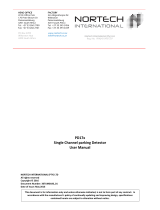
Manual LC10-*
Installation
2016-11
13
Adjacent loops of the same circumference should differ from each other by 1 winding. This
prevents the loops from operating on the same frequency.
4.1.3 Loop test
After laying and sealing the insulating resistance of the loop must be measured against earth. It
must be at least 1 MOhm.
Important notice!
1. When laying in asphalt/concrete the loop must be buried deep enough not to be pressed
back out under driving load.
2. Twist the loop connection lead well (at least 20 times per meter) and lay permanently.
3. Firmly embed the loop and the connection lead. Loop movements can result in false
alarms.
4. Solder the connection points in the loop connection lead and insulate them well (e.g. dis-
tribution box + sealing)
5. Lay loop connection lead separately from high voltage cables.
6. Lead the connection lead also twisted in the switch cabinet up to the terminals of the loop
detector.
7. Do not lead loops over resistance mats of floor heating installations.
4.2 Installation
Installation LC10-*
The loop detectors are constructed within the 11-pole plug-in socket housing and can be
installed directly in switch cabinets. They can be fixed either on a 35 mm top hat rail or via
screw connections. Direct installation at the induction loop on location is also possible through
integration in an ISO housing. This method of installation is recommended for long loop
connection leads.
During switch cabinet installation care must be taken not to install the loop detectors directly
next to switch contactors for high voltage consumers in order to prevent interference.
Connection LC10-*
Loop detectors are control devices which are fully ready for operation without the need for
additional equipment when connected to the supply voltage and the induction loop. The
switching outputs are relay contacts with high breaking capacity which can directly trigger
contactors, valves and alternate current motors.
To reduce potential interference it is recommended to fit inductive consumers with R/C
protective circuits (47 Ohm / 0.1 µF).
The loop connection lead must be well twisted (at least 20 times per meter) all the way to the
connection terminals of the loop detector. The loop connection lead must be laid separately
from switching cables of high voltage consumers (not in the same cable conduit).
The proper design and correct laying of the loop are preconditions for the proper functioning of
the loop detector.




















